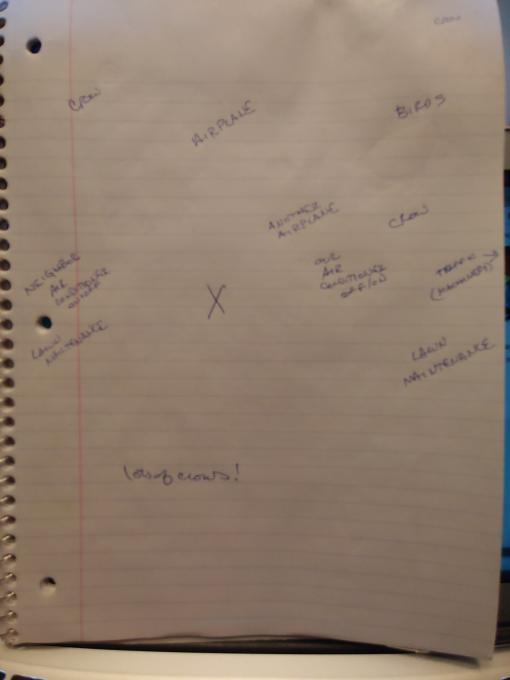The Cornell Lab Bird Academy › Discussion Groups › Inspiring Investigations through Citizen Science › Encouraging Observations
-
I'm afraid I had to complete this activity more than once as I kept getting distracted. My school is on the edge of a small town, has a prairie restoration garden right on the side of the school, another large one down the hill, and a retaining pond that has been planted with native plants. I found myself repeatedly lost in thoughts or just the enjoyoment of listening. Makes me wonder how challenging it might be for my students. It also reminded me of a listening activity I've done with students. I play a piece of mustic that I hope they haven't heard before, ususally instrumental although sometimes it is from an Italian opera. Their job is to find the story in the music and draw or write the story. Sometimes a student will get so caught up in the music that they don't write or draw anything - but can orally share what they heard.
-
I had to specifically focus on one noise because I was getting distracted as well!
-
-
Since I live in a large city, I found the competition between natural and industrial noises to be interesting. So many sounds exist to get the attention of humans, such as car horns and ice cream trucks, while the birds and cicadas are trying to make themselves heard without us in mind at all.
-
 Creating my sound map really helped me to tune in to everything that makes up the wind (not to mention being a great way to start the day with some fresh air!) It was a wet and windy morning, and I was really able to tune in with all the different sounds that make up the wind. It sounds much different this spring, as last year our woods were devastated by the Derecho that hit the midwest. Our neighborhood is at the top of a hill coming off a river valley, and it took a huge hit snapping trees in half when the storm hit. I was able to discern tree branches hitting each other, some snapping as they fell, rain in the trees as it fell to different surfaces, and the leftover leaves from fall rustling somewhere in the tree top. This is a great activity to take time to observe and notice, hopefully prompting students to ask questions, ponder, and reflect, let alone get away from screens for a few minutes and notice the world around them.
Creating my sound map really helped me to tune in to everything that makes up the wind (not to mention being a great way to start the day with some fresh air!) It was a wet and windy morning, and I was really able to tune in with all the different sounds that make up the wind. It sounds much different this spring, as last year our woods were devastated by the Derecho that hit the midwest. Our neighborhood is at the top of a hill coming off a river valley, and it took a huge hit snapping trees in half when the storm hit. I was able to discern tree branches hitting each other, some snapping as they fell, rain in the trees as it fell to different surfaces, and the leftover leaves from fall rustling somewhere in the tree top. This is a great activity to take time to observe and notice, hopefully prompting students to ask questions, ponder, and reflect, let alone get away from screens for a few minutes and notice the world around them. -
I really liked this activity of going outside with just my notebook and pencil and sitting still and observing. This is something I do not do often, nor do we give our students much time to do this. I was very surprised to hear so many nature sounds, whilst living in the city. I heard all kinds of bird calls and it was interesting trying to decipher where they were coming from. It also made me realize just how many noises our brains seem to ignore, until we really listen for them.
-
The most impactful thing about creating my sound map was sitting still with my eyes closed, and honestly not bringing anything outside me except for my pen and notebook. We so rarely sit and 'don't do anything' for such a long time it's habit for us to fiddle with things and try to distract ourselves. I would ask students to leave all devices inside and only bring something to write with and something to write on. I would encourage them to close their eyes for at least part of the time and get past the noises they know are there, to the less obvious ones.
-
Agreed, I often ask students when the last time they just sat in silence was! Our school library (my classroom is at the back of it) is very quiet in the morning, but every student is sitting in their online college classes with headphones on, so the quiet is deceiving. I should take the time to start my day like this every day!
-
-
I decided to do my sound map at night. We live on a wetland. Our RV is parked conveniently near the wetland edge. I lay on the bed with the windows open to avoid staying outside and hearing the sound of mosquitoes chewing on me!

-
I love the idea of doing the sound map at night! It would make it harder to see, and you'd be more reliant on your ears. Also, there's a host of different sounds at night than during the day. Plus, it sounds like your setting would be pretty perfect to listen to nature any time of day!
-
-
 I live in the city so my sound map has a lot of human produced noises. Sometimes it is heard to hear past the noisiness of the cars, buses, people and air-conditioners. When you do get past these, you can hear some of the natural aspects around you... such as insects buzzing and birds chirping from every direction.
I like how with an activity like this you can instruct your students to just be present. Even though we are listening, do not focus too intently on one direction of one sound. When we are able to do this, I feel as if I can hear more. It takes the ability to dismiss or fixate on a noise you think of as a "distraction".
I live in the city so my sound map has a lot of human produced noises. Sometimes it is heard to hear past the noisiness of the cars, buses, people and air-conditioners. When you do get past these, you can hear some of the natural aspects around you... such as insects buzzing and birds chirping from every direction.
I like how with an activity like this you can instruct your students to just be present. Even though we are listening, do not focus too intently on one direction of one sound. When we are able to do this, I feel as if I can hear more. It takes the ability to dismiss or fixate on a noise you think of as a "distraction". -
I thought I had already posted this but oops, I did not! I thought it was interesting to focus only on sounds. I think it would be interesting to do 10 minutes on sound and then 10 minutes on vision. Maybe smell too but not for long. This would be great for introducing observation as part of the scientific method.

-
I had never made a sound map before, or even heard of this! I went out in my backyard, sat in a comfortable chair, closed my eyes, and listened. It was the noisiest cacophony of sound! I could not believe how noisy it was – layer upon layer of sounds! There were deafening cicadas buzzing extremely loud, all kinds of birds chirping and singing (I’m new to birding so I was not able to identify any of the birds by their song or sounds), cars on a local road nearby that were louder than I had ever noticed with one even honking, a dog barking, a person shouting, my fountain splashing, air conditioner fans running – all simultaneously. It was amazing! I know my students would enjoy doing this. And what is nice is that this is an activity that can be done anywhere. It can be done at school or at home this fall if students are still virtually learning. During the pandemic I have been learning more about being mindful and in the moment. This activity ties into that practice. It is an easy way to get students to be more mindful and aware of the world all around them by focusing on one sense – hearing!

-
Sound maps are a sensory activity designed to help people connect with nature. We are located around a large lake that provides ample opportunities for outdoor studies. By taking the emphasis off the visual, and tuning students into the sounds around them, they have proved effective with all the groups we have used them with thus far.

-
For both adults and children in our fast paced society it can be difficult to just be still. This activity forced me to be still and to focus on sound. At first it was difficult to hear anything but my neighbors lawn mower but after a few minutes I was able to isolate and block out that sound and hear more. I was able to hear tree branches swaying, leaves brushing against one another, birds chirping and the gentle hum of an idling car in the driveway of a neighbors home. I enjoyed this activity and think it would be interesting to do with children in various places so they could compare their sound maps.
-
In the past, I have also completed an activity much like the Lemon activity, using sticks and nature journaling. I love the lemon or clementine idea because this better emphasizes the need to make careful observations, measurements, etc... as oftentimes, there are many distinguishing factors with sticks. I can easily incorporate this into my first lesson of the year.
-
I have done sound maps before and with my students, however today I am in an urban setting where the man-made sounds are taking over. I am not used to this type of environment but I felt it interesting that I actually had to close my eyes and "tune into" the sounds I was hearing. It wasn't until I did that, that I was able to hear the sounds of the cicadas over the sounds of the generator or cars around me.

-
I had a very similar experience. It took me a little while to isolate the sounds and hear nature over the man made sounds.
-
-
 Sound map with compass rose and informal legend. Front stoop of my apartment building was my vantage point.
Personal impact: Sad realization that there is a lot of construction noise in my small town which drowns out the sounds of nature. Happy realization that there is some wonderful native bird species that are making their homes in the centre of the city and grateful for the sound buffer created by the maples and locust trees that surround my home.
Professional impact: Sound mapping provides a challenge for my students, all of whom are Deaf or hard-of-hearing. My first thought was that this activity is not accessible to my students but I revisited my bias and determined that I would like to introduce my students to sound mapping in the fall to create at least one sound map per season during the 2020-2021 school year. This would be done as a fully guided group project on a large piece of chart paper. Some students will hear many more sounds that others. Students would also be encouraged to look for movement within the environment and predict if it makes sounds and what type of sound it would make. We would watch for animal mouths/beaks opening and shutting. Are the animals making sounds? or just breathing? or eating? how do we know? If the animals are making sounds, why? What are they trying to communicate? In class extension would take place by watching videos of the animals we observe on our school ground. We would slow the video down to carefully watch the mouth/beak movement and patterns. We could also watch sound waves through the app "Spectrum View" on our iPads when in the field.
Sound map with compass rose and informal legend. Front stoop of my apartment building was my vantage point.
Personal impact: Sad realization that there is a lot of construction noise in my small town which drowns out the sounds of nature. Happy realization that there is some wonderful native bird species that are making their homes in the centre of the city and grateful for the sound buffer created by the maples and locust trees that surround my home.
Professional impact: Sound mapping provides a challenge for my students, all of whom are Deaf or hard-of-hearing. My first thought was that this activity is not accessible to my students but I revisited my bias and determined that I would like to introduce my students to sound mapping in the fall to create at least one sound map per season during the 2020-2021 school year. This would be done as a fully guided group project on a large piece of chart paper. Some students will hear many more sounds that others. Students would also be encouraged to look for movement within the environment and predict if it makes sounds and what type of sound it would make. We would watch for animal mouths/beaks opening and shutting. Are the animals making sounds? or just breathing? or eating? how do we know? If the animals are making sounds, why? What are they trying to communicate? In class extension would take place by watching videos of the animals we observe on our school ground. We would slow the video down to carefully watch the mouth/beak movement and patterns. We could also watch sound waves through the app "Spectrum View" on our iPads when in the field. -
 I am continually impressed by the variety of sounds in my backyard at any given time. This time I did not hear the high pitched cack-cack-cack of the neighborhood sharp-shinned hawk, but much more variety of mechanical sounds than usually heard within 10 minutes. Mowers, traffic and helicopters, oh my! I heard bird activity primarily close by due to the tree cover and my neighbor's well-stocked bird feeders :D. Always a cardinal and house wren singing. The dogs barked before the sudden siren, which I found interesting. The combination of all of these sounds together, including my husband's voice on the phone through the open window of our house and the sound of the breeze through the trees just felt like a very rounded representation of home to me. I have used sound mapping exercises a lot during outings with families or groups. It helps calm everyone down to focus on the world outside themselves and all around them. I often will stop and do a one-minute 'sounds around' inventory at different points on a walk, in different types of habitats, so we can discuss the similarities and differences between stops.
I am continually impressed by the variety of sounds in my backyard at any given time. This time I did not hear the high pitched cack-cack-cack of the neighborhood sharp-shinned hawk, but much more variety of mechanical sounds than usually heard within 10 minutes. Mowers, traffic and helicopters, oh my! I heard bird activity primarily close by due to the tree cover and my neighbor's well-stocked bird feeders :D. Always a cardinal and house wren singing. The dogs barked before the sudden siren, which I found interesting. The combination of all of these sounds together, including my husband's voice on the phone through the open window of our house and the sound of the breeze through the trees just felt like a very rounded representation of home to me. I have used sound mapping exercises a lot during outings with families or groups. It helps calm everyone down to focus on the world outside themselves and all around them. I often will stop and do a one-minute 'sounds around' inventory at different points on a walk, in different types of habitats, so we can discuss the similarities and differences between stops. -
I laid in my hammock for 45 minutes and recorded ever natural noise I heard which included 15 different birds, 3 very active squirrels, wind rustling in the leaves above, and 10 chickens that decided to come hangout under the hammock. I tried to identify some of the sounds using Merlin.
-
Identification of sound through phone apps is quite amazing, isn't it. I was also recently made aware of a sound spectrum app to look at the sound waves made by birds (and other sources of sound). It is called Spectrum View and it is quite interesting to see the range of pitch and the complexity of calls in a visual way.
-
-
 I have done the Sound Map many times with children. I enjoy engaging in it also. I have never done this activity in my own backyard; a few of the sounds, I realized later, were daily occurrences at the time I did the activity. One of the activities I have had my students do, I'm sure other people have done also, is sitting back to back. One student finds an object to describe in detail while the other student tries to draw what is described to them. It is great for honing observation skills and enhancing descriptive techniques besides being a lot of fun.
I have done the Sound Map many times with children. I enjoy engaging in it also. I have never done this activity in my own backyard; a few of the sounds, I realized later, were daily occurrences at the time I did the activity. One of the activities I have had my students do, I'm sure other people have done also, is sitting back to back. One student finds an object to describe in detail while the other student tries to draw what is described to them. It is great for honing observation skills and enhancing descriptive techniques besides being a lot of fun. -
I love the extension of having two people back to back communicating! Planning to add as a sensory activity for my walks.
-
Thanks for sharing the back to back idea! I am going to add that to my list of activities for students to experience the outdoors in a new way and hone their powers of observation.
-
-
This activity highlights the fact that we tend to ignore a large part of our sensory system. If you make intentional time to listen and observe, you will uncover things that are often ignored. Crickets, Train, Frogs, cars, owl, three different insect or small animal noises, movement in the attic (yikes!!)
-
 While I was doing my sound map, I think the most impactful thing that I noticed was just how if you focus, you can hear wildlife all around the loudest human made noise (lawnmowers!!). I like to encourage children that I work with to listen to wildlife by cupping their hands around their ears, and turning them into "deer ears". Especially for younger children, this helps them focus on what their hearing and which direction it's coming from.
While I was doing my sound map, I think the most impactful thing that I noticed was just how if you focus, you can hear wildlife all around the loudest human made noise (lawnmowers!!). I like to encourage children that I work with to listen to wildlife by cupping their hands around their ears, and turning them into "deer ears". Especially for younger children, this helps them focus on what their hearing and which direction it's coming from. -
One of the main lessons we try to teach our program participants is the importance of biodiversity. When we go out into the field, students get disheartened pretty quickly when they do not see any animals or they exclaim that it's not a healthy ecosystem because we aren't seeing any animal biodiversity. At this point I usually sit them down and do a "be silent and listen" exercise for a minute. I ask them to count how many different birds, insects, or other animals they hear. They are almost always amazed to find they hear way more than one animal. I then ask if we heard every single animal that may make use of the area we are in and why. This short exercise seems to open their eyes on how much biodiversity is around them, whether they can see it or not. It reveals itself when you take a moment to stop and listen.

-
I recently read an article about scientists collecting general recordings of different world habitats using AI technology so as to evaluate healthy and impaired systems. I love that you get your students thinking this way about the diversity of sound as an observation technique regarding the whole ecosystem!
-
Kristen I like how you use this activity to let your students discover biodiversity and disprove their initial assumptions. Powerful! And also a great way for students that may be in a more urban setting to realize “nature” is not absent from their neighborhood either.
-
-
I live in an apartment complex, and it is fairly quiet. I mostly heard crows talking to each other, along with a few other birds here and there. A big thing that I noticed happened when the neighbors outside air conditioner unit stopped (ours was also off during the first part of my sound map activity), was how much difference the background noise made to listening to my environment! Which made me think about noise pollution that exists around us every day. with air conditioners not running, I could hear faint sounds of traffic and construction machinery, and birds that were further away. With and without air conditioning, I noticed a couple high flying aircraft flying by, sounds of the lawn maintenance crew around the complex with their various devices, and the noisy crows from all areas. I definitely think having students close their eyes and just record what they are hearing without talking about it during the observation time helps with observation skills. I also like the idea of noting distance (close or far away) of the sounds they hear. I would have students discuss what they heard afterwards, and then follow up with other activities such as observing with smell only, or touch only.

-
For me when creating the sound map the larger the image of what made a sound the louder the sound the smaller the image the softer the sound. The most impactful thing about creating the sound map was that some sounds further away were louder than closer sounds, this being due to whatever made the sound. To encourage children to use their senses to observe the natural world more fully I would encourage them to not only listen with their eyes closed, but have them think about what the smells are around them, how do they feel (warm, cold, happy, excited, afraid, calm, etc.), and how do things within reach, without getting up, feel to the touch (this would require making sure area free of things like poison oak). Then at the end have students open their eyes and see what things look like in reality compared to what they imaged in their mind with their eyes closed and can journal write or draw the likeness and differences.

-
I like your idea of noting how far away sounds are by the size of your pictures! Adding feelings to the mix is interesting, also - there are definitely sounds that freak me out or give me serenity...I don't know it I could classify all sounds, though, in feelings. Great ideas!
-
-

-
I did this activity with my daughter and it was very interesting seeing how we each depicted sounds differently. I was really able to appreciate how closing my eyes helped to focus on the sounds.
-
-
tractor? (v. distant, constant) distant cars (occasional) bullfrog? (v. distant, occasional) leaves rustling leaves rustling leaves rustling cars insect driving hitting past screen (slowing cicadas X at trilling toads stick curve) falling leaf skittering along stone walkway I often do a very similar project to the Lemons with oranges or pinecones (actually usually spruce cones) for nature studies. Like the Lemon one, try to get very similar looking ones and have some extras, but I only give vague instructions once they receive it - "look at your cone carefully" for a few minutes. Usually only a few students are able to find theirs - often ones with a distinctive mark but usually a few that were just more carefully observed. This immediately creates a desire for the rest of the students to look at their cone more carefully and we discuss/brainstorm ways before redistributing for a second look (randomly, not trying to give them their original cone back). This is sometimes part of a larger nature studies program that includes plant identification, taxonomy, nature sketching, etc and we return to the concept different ways: using for observational skills to draw more accurately, using to compare/contrast features often used in identification guides, etc.
-
Oops! The text version of sound map did not retain its format when submitted!!
-
-
I have done this activity before and with my students. Today when I went outside my neighbor was chipping branches down the hillside. So that was definitely the most prominent sound in the landscape. Although I live up a hill, I can hear the roadside down below as the cars pass along the road through our little valley. With all the wood chipping noise I wasn't able to hear that well, but I did hear Chestnut-backed Chickadees calling back and forth from several different spots in my yard. There is very little that deters them. To me, they are always the bravest birds. They are not particularly afraid of people. I could hear a pair of hummingbirds doing their scritchy-scratchy scree talk. They were probably Anna's Hummingbirds, as that is who is usually around here and they tend to be very territorial with the feeders. Off toward the barn I could hear the California Jays first with a mild alert call, and then several jays with the general squawk they tend to make. Up in the Acacia's I could hear a Hooded Oriole doing its clicking talk. They are very shy, and tend to hide out in the Acacia's or the Box Elder Trees before swooping down to the feeders I have set up for them. They bring their children, who are less shy, and bring them to feed. It is my first year they have come to my yard, and I have been really excited to see them over the last few months each day. I heard another call, like a to, to, to with a ping pong ball drop, but I don't know who that was. Given my neighbors loud chipper it wasn't the best time for listening, but everyone is busy with projects, and also prepping for fire season. So we have all been working on our trees and landscape to keep our community safe. I observe my yard everyday both from inside and outside the house. It is nice to take time to focus solely on hearing what is in the landscape and developing a keener awareness of what is occurring within just 1 sense field. Kids enjoy this, but it tends to take them a few times to really bring their attention to this activity and how to describe what they are hearing to help them get a sense of how to map this out on paper.

-
You are very knowledgeable about what you hear! This would be a great activity for trying to note sounds and try to figure out what birds you are actually hearing. Then start showing birds and their sounds, followed by revisits to the listening activity to see what birds they could identify :)
-
Read More:
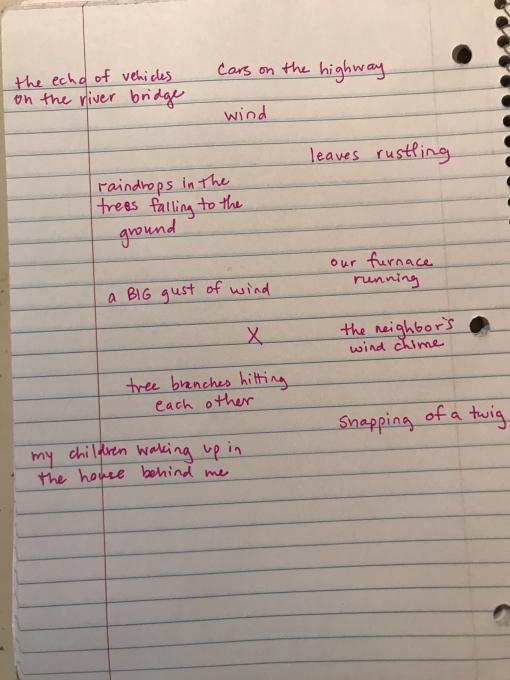 Creating my sound map really helped me to tune in to everything that makes up the wind (not to mention being a great way to start the day with some fresh air!) It was a wet and windy morning, and I was really able to tune in with all the different sounds that make up the wind. It sounds much different this spring, as last year our woods were devastated by the Derecho that hit the midwest. Our neighborhood is at the top of a hill coming off a river valley, and it took a huge hit snapping trees in half when the storm hit. I was able to discern tree branches hitting each other, some snapping as they fell, rain in the trees as it fell to different surfaces, and the leftover leaves from fall rustling somewhere in the tree top. This is a great activity to take time to observe and notice, hopefully prompting students to ask questions, ponder, and reflect, let alone get away from screens for a few minutes and notice the world around them.
Creating my sound map really helped me to tune in to everything that makes up the wind (not to mention being a great way to start the day with some fresh air!) It was a wet and windy morning, and I was really able to tune in with all the different sounds that make up the wind. It sounds much different this spring, as last year our woods were devastated by the Derecho that hit the midwest. Our neighborhood is at the top of a hill coming off a river valley, and it took a huge hit snapping trees in half when the storm hit. I was able to discern tree branches hitting each other, some snapping as they fell, rain in the trees as it fell to different surfaces, and the leftover leaves from fall rustling somewhere in the tree top. This is a great activity to take time to observe and notice, hopefully prompting students to ask questions, ponder, and reflect, let alone get away from screens for a few minutes and notice the world around them. 
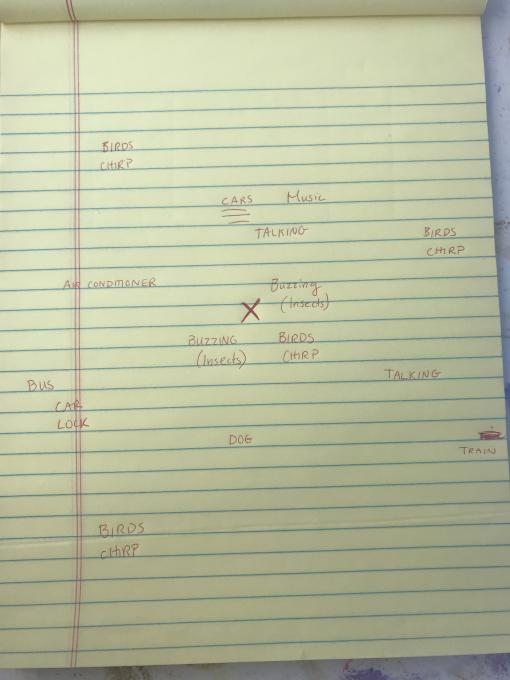 I live in the city so my sound map has a lot of human produced noises. Sometimes it is heard to hear past the noisiness of the cars, buses, people and air-conditioners. When you do get past these, you can hear some of the natural aspects around you... such as insects buzzing and birds chirping from every direction.
I like how with an activity like this you can instruct your students to just be present. Even though we are listening, do not focus too intently on one direction of one sound. When we are able to do this, I feel as if I can hear more. It takes the ability to dismiss or fixate on a noise you think of as a "distraction".
I live in the city so my sound map has a lot of human produced noises. Sometimes it is heard to hear past the noisiness of the cars, buses, people and air-conditioners. When you do get past these, you can hear some of the natural aspects around you... such as insects buzzing and birds chirping from every direction.
I like how with an activity like this you can instruct your students to just be present. Even though we are listening, do not focus too intently on one direction of one sound. When we are able to do this, I feel as if I can hear more. It takes the ability to dismiss or fixate on a noise you think of as a "distraction". 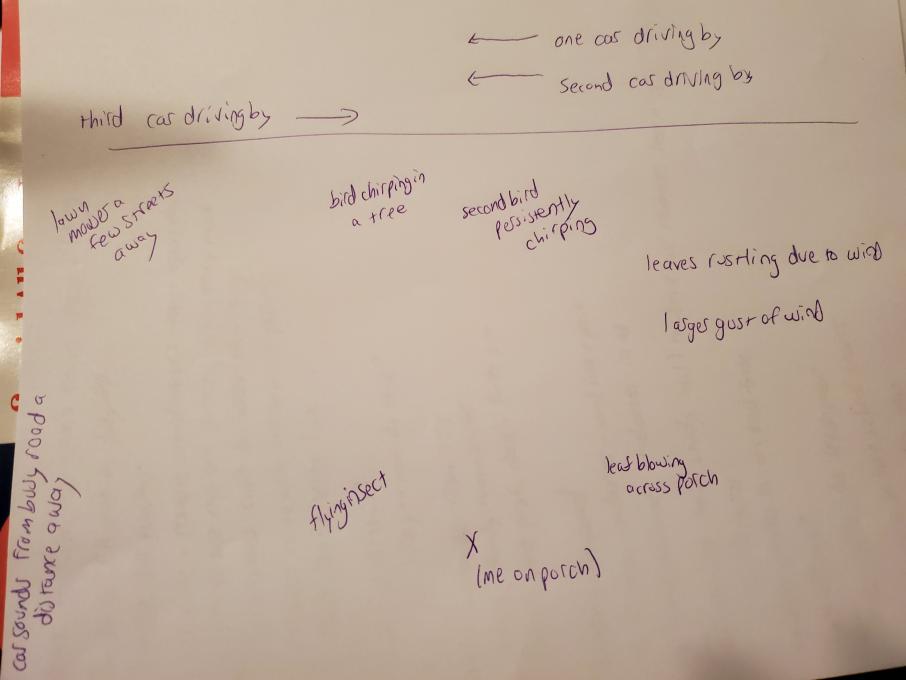



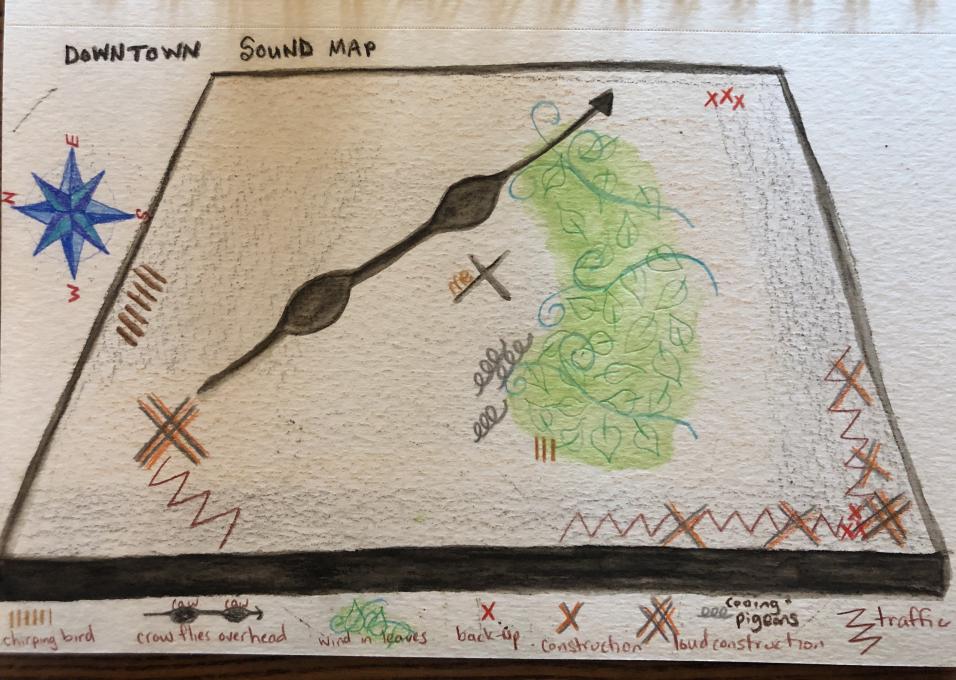 Sound map with compass rose and informal legend. Front stoop of my apartment building was my vantage point.
Personal impact: Sad realization that there is a lot of construction noise in my small town which drowns out the sounds of nature. Happy realization that there is some wonderful native bird species that are making their homes in the centre of the city and grateful for the sound buffer created by the maples and locust trees that surround my home.
Professional impact: Sound mapping provides a challenge for my students, all of whom are Deaf or hard-of-hearing. My first thought was that this activity is not accessible to my students but I revisited my bias and determined that I would like to introduce my students to sound mapping in the fall to create at least one sound map per season during the 2020-2021 school year. This would be done as a fully guided group project on a large piece of chart paper. Some students will hear many more sounds that others. Students would also be encouraged to look for movement within the environment and predict if it makes sounds and what type of sound it would make. We would watch for animal mouths/beaks opening and shutting. Are the animals making sounds? or just breathing? or eating? how do we know? If the animals are making sounds, why? What are they trying to communicate? In class extension would take place by watching videos of the animals we observe on our school ground. We would slow the video down to carefully watch the mouth/beak movement and patterns. We could also watch sound waves through the app "Spectrum View" on our iPads when in the field.
Sound map with compass rose and informal legend. Front stoop of my apartment building was my vantage point.
Personal impact: Sad realization that there is a lot of construction noise in my small town which drowns out the sounds of nature. Happy realization that there is some wonderful native bird species that are making their homes in the centre of the city and grateful for the sound buffer created by the maples and locust trees that surround my home.
Professional impact: Sound mapping provides a challenge for my students, all of whom are Deaf or hard-of-hearing. My first thought was that this activity is not accessible to my students but I revisited my bias and determined that I would like to introduce my students to sound mapping in the fall to create at least one sound map per season during the 2020-2021 school year. This would be done as a fully guided group project on a large piece of chart paper. Some students will hear many more sounds that others. Students would also be encouraged to look for movement within the environment and predict if it makes sounds and what type of sound it would make. We would watch for animal mouths/beaks opening and shutting. Are the animals making sounds? or just breathing? or eating? how do we know? If the animals are making sounds, why? What are they trying to communicate? In class extension would take place by watching videos of the animals we observe on our school ground. We would slow the video down to carefully watch the mouth/beak movement and patterns. We could also watch sound waves through the app "Spectrum View" on our iPads when in the field. 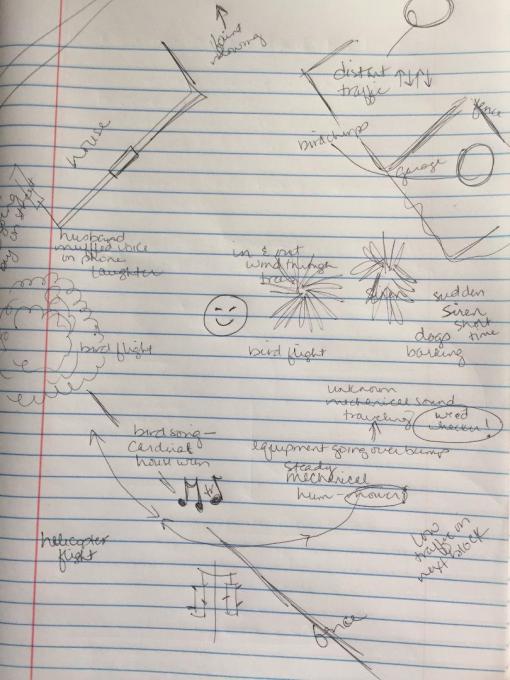 I am continually impressed by the variety of sounds in my backyard at any given time. This time I did not hear the high pitched cack-cack-cack of the neighborhood sharp-shinned hawk, but much more variety of mechanical sounds than usually heard within 10 minutes. Mowers, traffic and helicopters, oh my! I heard bird activity primarily close by due to the tree cover and my neighbor's well-stocked bird feeders :D. Always a cardinal and house wren singing. The dogs barked before the sudden siren, which I found interesting. The combination of all of these sounds together, including my husband's voice on the phone through the open window of our house and the sound of the breeze through the trees just felt like a very rounded representation of home to me. I have used sound mapping exercises a lot during outings with families or groups. It helps calm everyone down to focus on the world outside themselves and all around them. I often will stop and do a one-minute 'sounds around' inventory at different points on a walk, in different types of habitats, so we can discuss the similarities and differences between stops.
I am continually impressed by the variety of sounds in my backyard at any given time. This time I did not hear the high pitched cack-cack-cack of the neighborhood sharp-shinned hawk, but much more variety of mechanical sounds than usually heard within 10 minutes. Mowers, traffic and helicopters, oh my! I heard bird activity primarily close by due to the tree cover and my neighbor's well-stocked bird feeders :D. Always a cardinal and house wren singing. The dogs barked before the sudden siren, which I found interesting. The combination of all of these sounds together, including my husband's voice on the phone through the open window of our house and the sound of the breeze through the trees just felt like a very rounded representation of home to me. I have used sound mapping exercises a lot during outings with families or groups. It helps calm everyone down to focus on the world outside themselves and all around them. I often will stop and do a one-minute 'sounds around' inventory at different points on a walk, in different types of habitats, so we can discuss the similarities and differences between stops.  I have done the Sound Map many times with children. I enjoy engaging in it also. I have never done this activity in my own backyard; a few of the sounds, I realized later, were daily occurrences at the time I did the activity. One of the activities I have had my students do, I'm sure other people have done also, is sitting back to back. One student finds an object to describe in detail while the other student tries to draw what is described to them. It is great for honing observation skills and enhancing descriptive techniques besides being a lot of fun.
I have done the Sound Map many times with children. I enjoy engaging in it also. I have never done this activity in my own backyard; a few of the sounds, I realized later, were daily occurrences at the time I did the activity. One of the activities I have had my students do, I'm sure other people have done also, is sitting back to back. One student finds an object to describe in detail while the other student tries to draw what is described to them. It is great for honing observation skills and enhancing descriptive techniques besides being a lot of fun. 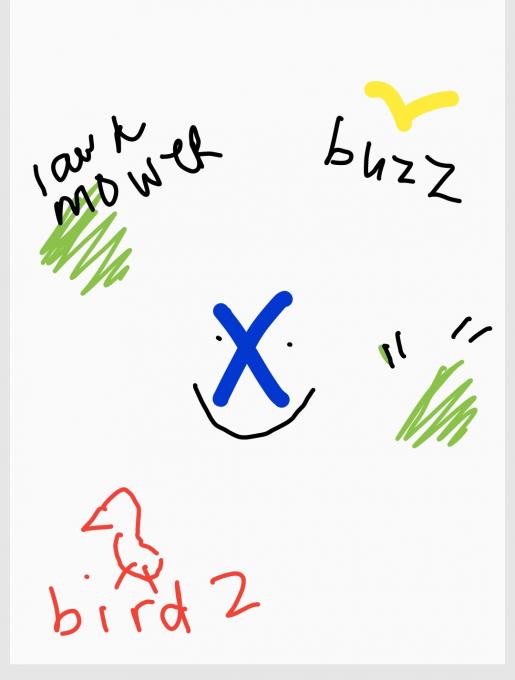 While I was doing my sound map, I think the most impactful thing that I noticed was just how if you focus, you can hear wildlife all around the loudest human made noise (lawnmowers!!). I like to encourage children that I work with to listen to wildlife by cupping their hands around their ears, and turning them into "deer ears". Especially for younger children, this helps them focus on what their hearing and which direction it's coming from.
While I was doing my sound map, I think the most impactful thing that I noticed was just how if you focus, you can hear wildlife all around the loudest human made noise (lawnmowers!!). I like to encourage children that I work with to listen to wildlife by cupping their hands around their ears, and turning them into "deer ears". Especially for younger children, this helps them focus on what their hearing and which direction it's coming from. 
